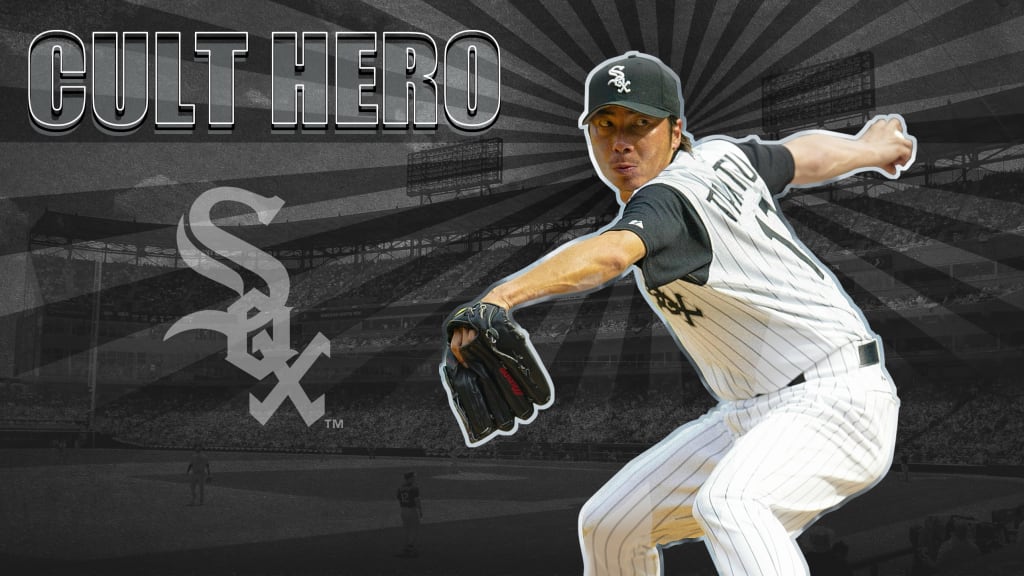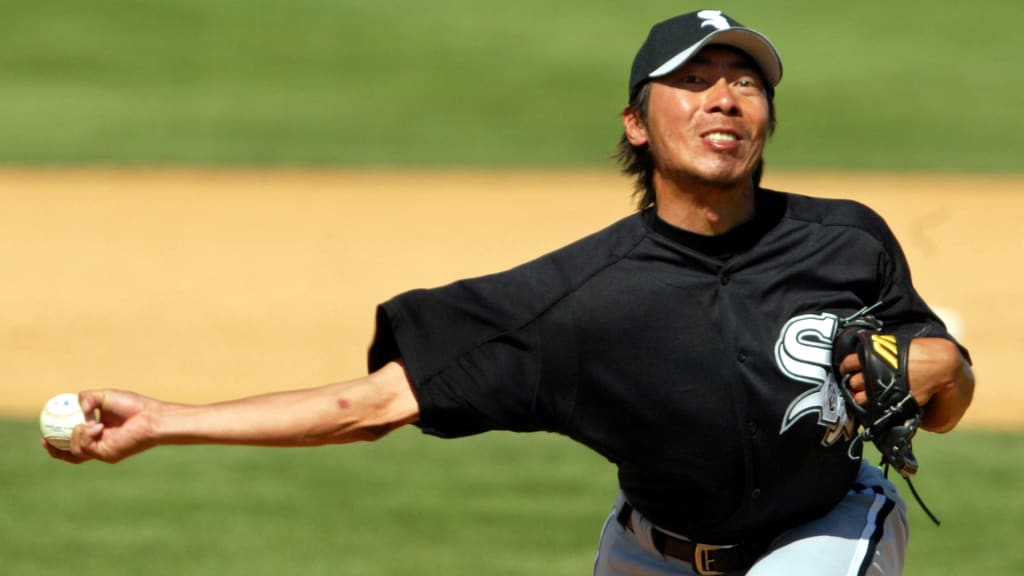
CHICAGO -- When Shingo Takatsu comes up in conversation, two words immediately come to mind.
“The gong,” said White Sox pitching coach Don Cooper with a broad smile.
Takatsu was a pitcher for the 2004 White Sox who was with them for part of the '05 World Series championship season, and the first Japanese player in franchise history.
But the 35-year-old rookie's presence took on a cult-hero life of its own. Each Takatsu save situation was eventually preceded by the infamous gong ringing out through U.S. Cellular Field that signaled his entrance.
In 59 games and 62 1/3 innings during the 2004 campaign, Takatsu posted a 2.31 ERA with 19 saves and 50 strikeouts to finish second in the American League Rookie of the Year Award voting. It was how he got there, though, that made him so interesting.
Takatsu used a sidearm delivery, and his fastball averaged 86.5 mph, according to Fangraphs.
His changeup, meanwhile, averaged 68 mph, slow enough to throw off a hitter’s timing and also leave said hitter wondering how he swung through the previous pitch.
“They called it the 'Frisbee' I guess,” the now 51-year-old Takatsu told MLB.com during a recent interview from Japan, through interpreter Matt Hidaka. “That would be the one word to express how I pitched.”
“It’s like Bugs Bunny coming in,” said Brooks Boyer, the White Sox senior vice president of sales and marketing, who was hired by the team on May 1 of Takatsu’s rookie campaign. “People get to swing at it two or three times when they miss it.”
There was no real fanfare surrounding Takatsu’s arrival. As Takatsu readily admits, people weren’t beating down the door to sign this accomplished free agent who posted 260 saves over the previous 13 seasons with the Yakult Swallows.
So Takatsu held an open workout in Los Angeles, and the White Sox had interest. According to executive vice president Ken Williams, the team’s general manager at the time, the club made the decision to bring in Takatsu after watching video.
“You watch games and sometimes they are Japanese games, and I don’t know what else to say. I saw him on TV and thought he should be able to help us for a little while,” Williams said. “I remember Don Cooper looking at me, saying, ‘Who is this guy we are bringing over? And who saw him?’ I said, ‘I saw him on tape. He’ll be fine. Don’t mess him up.’”
“I have a very special place in my heart toward the White Sox because they were the ones who gave me that opportunity,” Takatsu said. “I don’t think I would be here where I’m at right now if it weren’t for the White Sox.”
Ozzie Guillen, who was in his first year as White Sox manager, was amazed by Takatsu’s success with basically one pitch: the Frisbee, as Takatsu humorously described it. That one pitch had to be guarded during Cactus League action during Spring Training.

In fact, the White Sox told the catchers not to call any changeups during those contests.
“He kept shaking off and shaking off. He wanted to throw it,” Guillen said. “We explained to him why we didn’t want to throw it: We didn’t want anybody to see it. I never [saw] anybody throw that kind of changeup, and he was ready every time we called him.”
“We were banking on it. We got him from Japan, and we weren’t bringing him over here for a tryout,” Cooper said. “He could go from 91 [mph] to 57 [mph]. His speed difference was very good. Certainly, different angle. That’s what I remember.”
“Mr. Zero,” as Takatsu was known in Japan because of the lack of runs he allowed, yielded two runs during his Major League debut on April 9 in Yankee Stadium, courtesy of Bubba Crosby’s two-run home run. Takatsu allowed another run in his third career outing, also against the Yankees. But Mr. Zero took effect afterward, and he tossed 26 1/3 consecutive scoreless innings over the next 24 games.
During that time, Takatsu picked up his first four wins, his first four holds and his first three saves. He also became a cultural phenomena among White Sox fans.
Boyer approached him before a game one day about adding the gong to his entrance, along with video they found of his time in Japan, and Takatsu was amenable to the entertaining change. The White Sox did their research, with Boyer pointing out they even found the difference between a Japanese gong and a Chinese gong.
“Honestly, I wasn’t expecting all that,” Takatsu said. “I didn’t know how successful I would be coming over to the Major Leagues in my first year. The team just went out of their way, and you know they created all of that kind of ... the gong and the video.
“The fans, I wasn’t expecting the fans to have that reaction. It did catch me by surprise, but I loved every moment of it.”
Unfortunately for Takatsu, that successful run and specific pitching style didn’t carry much past one season. Takatsu saved Mark Buehrle’s 1-0 season-opening victory over Cleveland in 2005, but, two games later, Casey Blake, Coco Crisp and Ronnie Belliard went deep against him in the ninth inning. Takatsu never really recovered, although he did record eight saves for the eventual World Series champs.
The White Sox released him Aug. 1, 2005, two weeks after he allowed three runs against the Indians. Takatsu received a championship ring, which he displays proudly and prominently in his Tokyo home, and finished his career with a 2.35 ERA over nine games for the Mets that same season.
“My only regret was not being able to pitch on that 2005 team toward the end of the season when we were in the playoffs and winning the World Series,” Takatsu said. “Other than that, I loved being a part of the White Sox organization.”
“He was an important piece for the White Sox,” Guillen added. “Besides that, he got along with the players. When you come from that part of the world, you [can be] very quiet, try to stay away from the players. He had fun with the team and the players. He was a good guy to have.”
Guillen’s admiration for Takatsu was returned by the pitcher, who enjoyed working for the entertaining and baseball-savvy manager.
“Playing for Ozzie was great. He was very influential, I would say, in my career,” Takatsu said. “He wouldn’t necessary be the prototypical manager I would like to become, but definitely there was a lot of points that I felt I could learn from him in his way of managing.
“I played under a lot of different managers throughout my career, and I would say I was the most relaxed playing under Ozzie. He always made it very comfortable for the players.”
Takatsu now works with one of his former White Sox teammates, Tadahito Iguchi, in Japan's Nippon Professional Baseball league. Iguchi manages the Chiba Lotte Marines and Takatsu runs the Swallows after managing one of their affiliates for three years.
Maybe some of Guillen’s personality really will rub off on Takatsu’s managerial style. But even as he tackles this latest baseball opportunity, Takatsu will always remember his almost instant ascent to stardom on the South Side of Chicago.
“Heading into it, I wasn’t expecting to really like the city of Chicago, or I didn’t know what to expect,” said Takatsu. “After all was said and done, I really, really enjoyed my time with the White Sox, and I really love the city of Chicago and their fans.”


